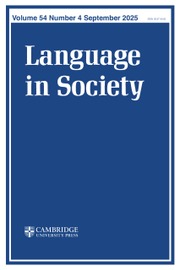Article contents
Action in interaction is conduct under a description
Published online by Cambridge University Press: 24 April 2017
Abstract
Requests, offers, invitations, complaints, and greetings are some of the many action types routinely invoked in the description and analysis of interaction. But what is the ontological status of, for instance, a request? In what follows I propose that action is conduct under a description. Thus, for the most part, interaction is organized independently of any action description or categorization of conduct into discrete action types. Instead, participants in interaction draw on the details of the situation in which they find themselves in order to produce conduct that others will recognize and to which they are able to respond in fitted ways. ‘Action’ still plays a key role in the organization of interaction, however, because accountability attaches not to raw conduct but only to conduct under some particular, action-formulating description. (Action, interaction, description, conversation analysis, Anscombe)*
- Type
- Articles
- Information
- Copyright
- Copyright © Cambridge University Press 2017
Footnotes
The analysis reported here was first presented at a workshop on action description at Ghent University (September 2016). I thank the participants in the workshop for many helpful comments and much lively discussion and Peter Muntigl for hosting me. For comments on an earlier written version I thank two anonymous reviewers for the journal as well as Nick Enfield and Giovanni Rossi.
References
REFERENCES
- 40
- Cited by





